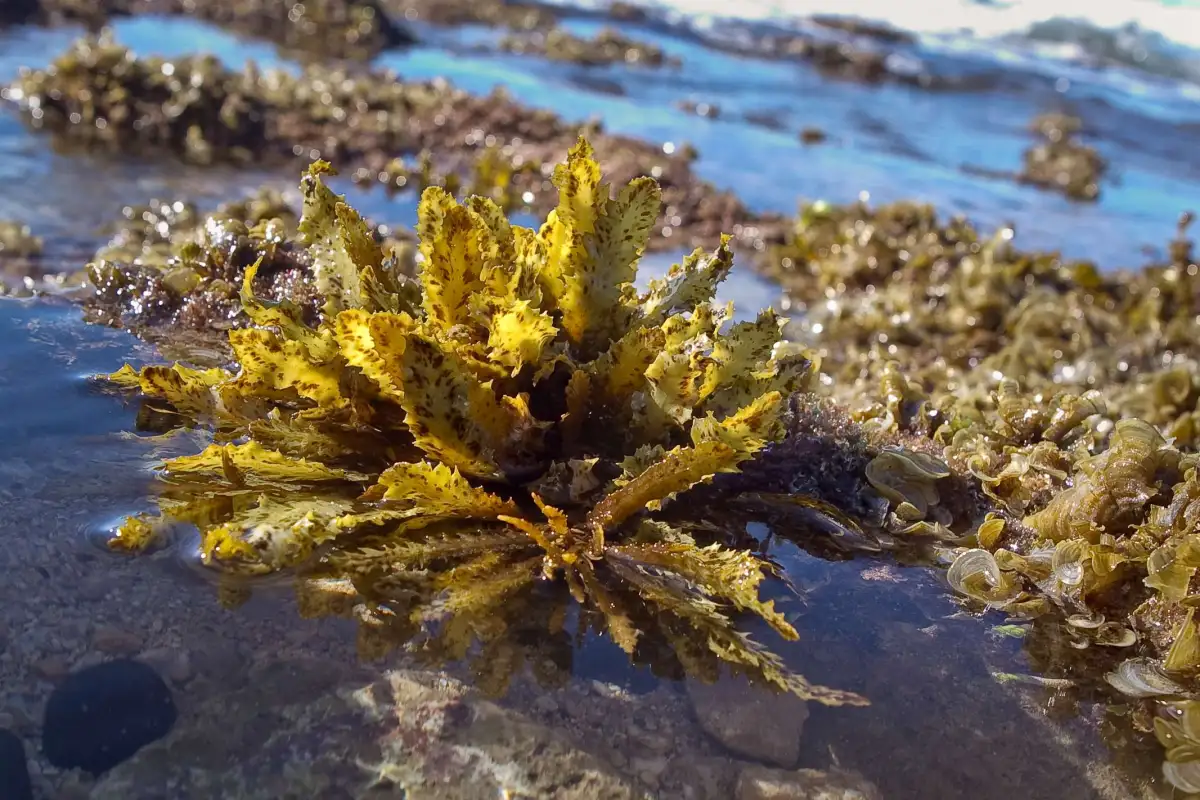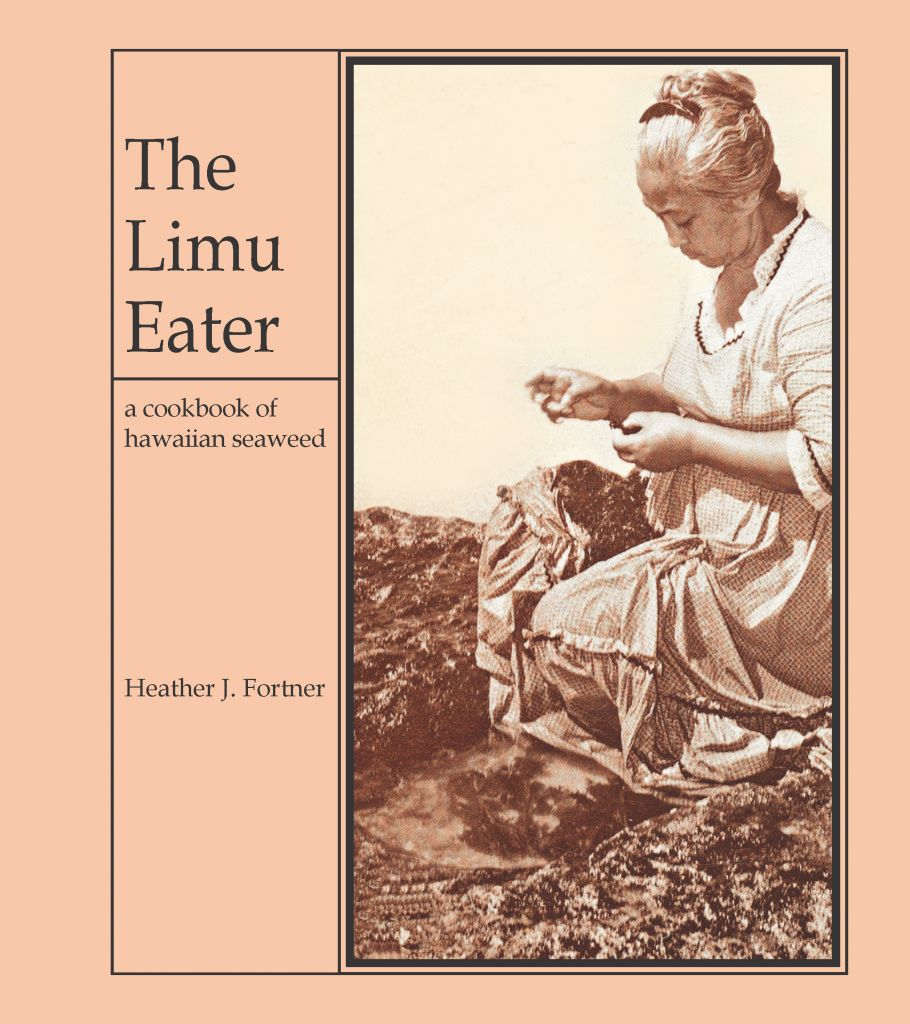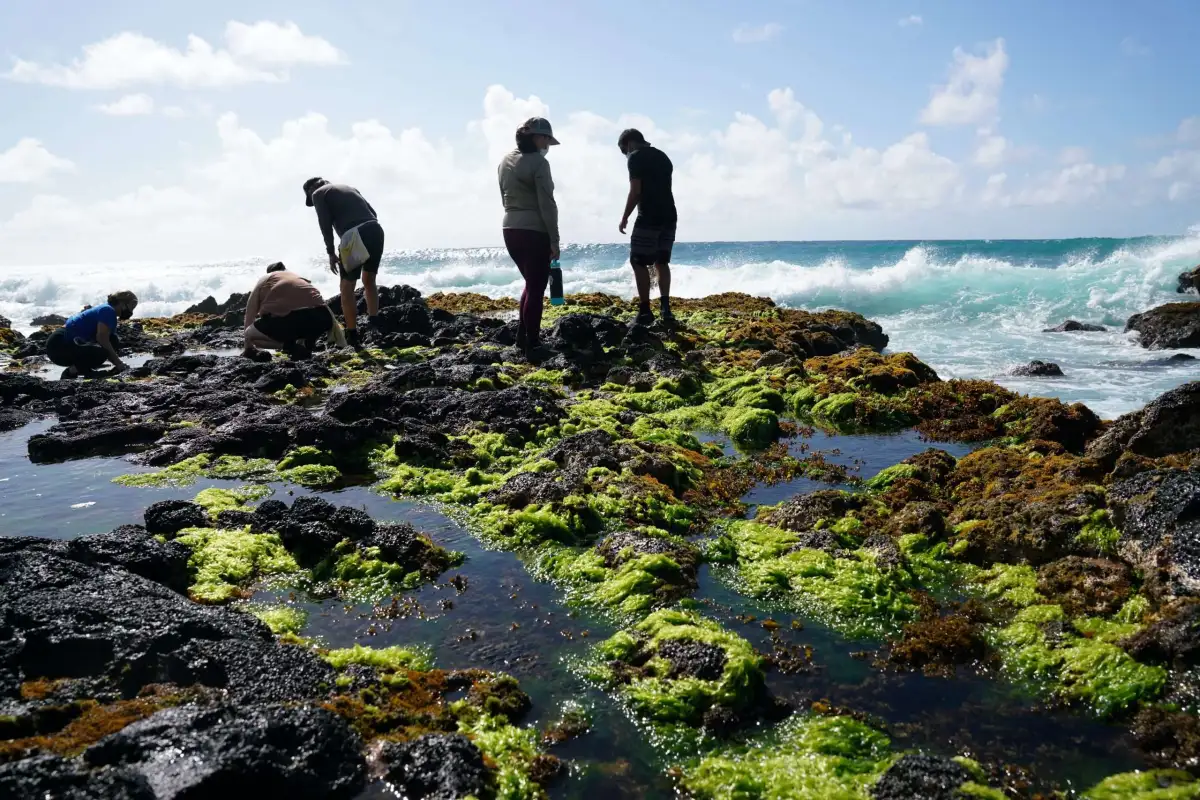
Limu Kala and Limu Pepeiao on the papa (reef flat). Photo Credit: Kim Moa, courtesy of KUA.
This month we are featuring limu in our recipe blog series. Traditional Hawaiian diets often feature poi, fish and limu. Limu is seaweed that provides incredible nutrients, vitamins and flavor to many culturally significant dishes, and remains a staple in Hawaiian cuisine. Since limu is a term also used to describe a variety of edible seaweeds, you can find a wide range of textures and flavors from the peppery taste of limu kohu to the fresh and crunchy delight of limu ‘akiʻaki.
Originally printed in 1978, Hawaii Sea Grant and Kuaʻāina Ulu ʻAuamo (KUA) teamed up last year to reprint The Limu Eater – A Cookbook of Hawaiian Seaweed, written by Heather J. Fortner. Their reprint honors the cultural history of limu. The cookbook reprint is among Limu Hui’s many activities to perpetuate limu knowledge, stewardship and cultural practices. Limu Hui is a network and program of KUA, which is a collaborating organization of the Indigenous Aquaculture Network.
To celebrate this delicious marine offering, we designed a three-course meal that highlights limu in each course. We start with limu tofu tempura, followed by a fresh limu manauea (also known as ogo) namasu salad. The main course is limu palahalaha wrapped baked fish. These recipes are from The Limu Eater, and are just a small sample of the dozens of incredible dishes outlined throughout the book.
Also check out Emily Akamine’s article on The Resilience of Limu to learn more about the significance of seaweed stewardship as cultural resilience in Hawai‘i, and for even more Limu Love, enjoy this talk-story video with our Limu Hui partners.

The Limu Eater Book Cover. Photo Credit: Hawaii Sea Grant
Appetizer: Limu Tofu Tempura
Ingredients:
1 cup limu, finely chopped (use salad type limu like palahalaha)
1 block tofu
2 tbsp sesame seeds, toasted
½ cup carrots, finely chopped
⅓ cup green beans, finely chopped
3 shrimps, cooked and chopped
2 tsp salt
3 eggs, beaten
4 tsp brown sugar
Oil for deep frying
¼ cup green onion (optional)
¼ cup limu ʻeleʻele, chopped (optional – for color and flavor)
Limu manauea (Ogo) (optional)
Instructions:
Place the tofu in a muslin cloth and squeeze to remove excess water. Grind the sesame seeds,
then add the tofu and the remaining ingredients except the oil; mix well. The consistency should be of a thick paste. Heat the oil to 375°F and drop the tofu mixture by teaspoonsful into the deep fryer, cooking until golden brown. Remove, drain on paper towels. Place hot atop a bed of chopped limu manauea (ogo). Serve with a mustard-shoyu dip.

Limu gatherers on the papa (reef flat). Photo Credit: Kim Moa, courtesy of KUA.
Salad: Limu Manauea (Ogo) Namasu
Ingredients:
1 lb. limu manauea (ogo)
1 tomato
½ Maui onion
1 cucumber
Marinade:
¼ cup vegetable oil
¼ cup cider vinegar
3 tbsp shoyu
2 tsp salt
1 tbsp sugar
¼ tsp fresh ginger, minced
Pinch pepper
Dash hot pepper sauce
1 tsp MSG (optional)
Instructions:
Wilt the seaweed, then drain and cut into 3-inch sections. Combine the ingredients for the marinade, set aside. Cut the tomato, onion, and cucumber into strips, add the limu manauea, and combine with the marinade. Let stand at least 2 hours before serving. ʻOpihi (Hawaiian limpets) are optional

A Limu lei made of Limu Huluhuluwaena and Limu Lepe o Hina. Photo Credit: Kinohi Fukumitsu, courtesy of KOA. Limu gatherers on the papa (reef flat). Photo Credit: Kim Moa, courtesy of KUA.
Main Course: Limu Palahalaha Wrapped Baked Fish
Originally, ti leaves were used to wrap fish to retain moisture. Here, limu palahalaha (also known as sea lettuce) “leaves” – a type of ulva seaweed – keeps the fish moist and can be eaten, too.
Ingredients:
Fish
Onion juice
Lemon juice
Butter
Large, roundish leaves of limu pālahalaha (about 6 per fish)
Instructions:
Use any fish or piece of fish large enough for baking, If using a whole fish, clean, gut, and scale it. Make a mixture of the onion juice, lemon juice, and butter. Spread liberally over the fish, inside and out. Wrap the fish securely In layers of the limu palahalaha and tie securely. Place in a baking pan with just a little water and bake at 375°F for 45 minutes or until the fish turns white and flakes easily. To serve, place on a platter and gently unfold the limu wrapping, discarding browned or burned sections. Eat the limu dipped in shoyu or lemon juice.
Olivia Horwedel is the current Communications Fellow for the Cross-Pacific Indigenous Aquaculture Collaborative Network.
